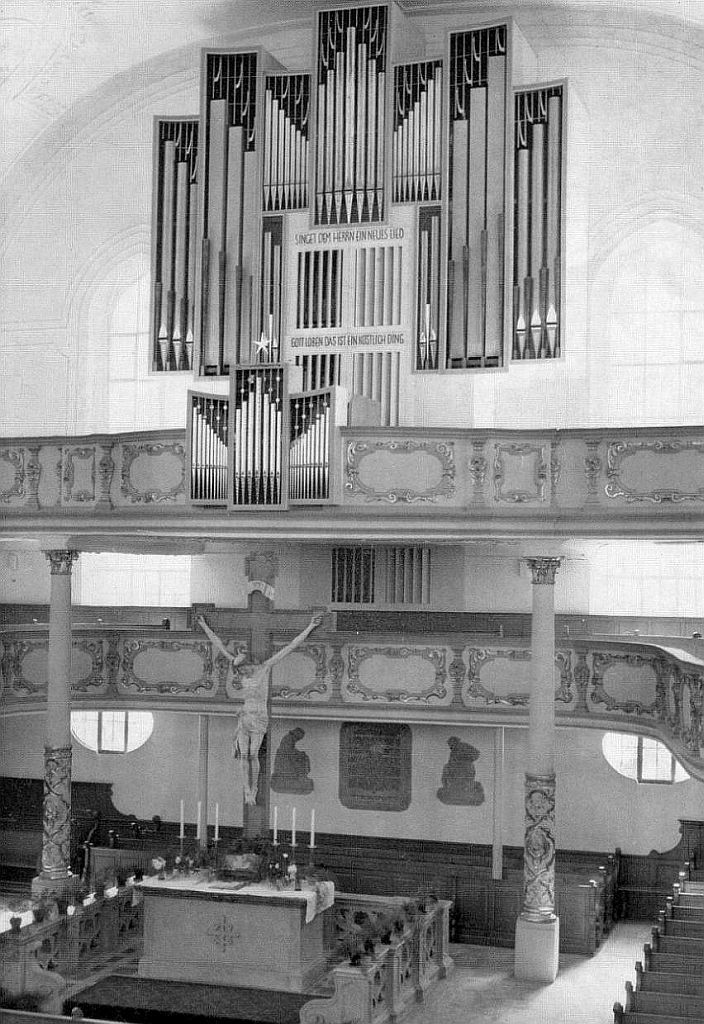Ausführliche Beschreibung der vorgewählten Orgel

Quelle: firma Gerhard Schmid
Argentine, France (Savoie (73)) - Résidence Paul Manuel
Weitergeleitet von: Kaufbeuren - Dreifaltigkeitskirche (1964 - 2011)
Gemeinde: Argentine
Region:Rhône-Alpes
Adresse:
Beschreibung nr.: 2015531.
Gebaut von: Gerhard Schmid (1964)
Kurze Übersicht der Orte, an denen die Orgel gestanden hat
Technische Daten
Disposition
Hauptwerk (Grundwerk) (C-g'''): Gedackt 16', Principal 8', Holzflöte 8', Gemshorn 8', Großquint 5 1/3', Octav 4', Rohrgedackt 4', Spitzquint 2 2/3', Octav 2', Terz 1 3/5', Mixtur 5 fach (1 1/3'), Scharff 3 fach (1'), Trompete 8'.
Rückpositiv (Scharfwerk) (C-g'''): Holzgedackt 8', Principal 4', Kleinpommer 2', Octav 1', Cymbel 3 fach (1/2'), Krummhorn 8', Tremulant, Schellencymbel.
Unterpositiv (Schwellpositiv) (C-g'''): Rohrflöte 8', Salicional 8', Gedacktflöte 4', Principal 2', Sifflöte 1 1/3', Regal 8', Tremulant.
Brustwerk (Farbwerk) (C-g'''): Spitzflöte 8', Quintade 8', Spitzgamba 8', Principal 4', Gemsflöte 4', Nasat 2 2/3', Blockflöte 2', Terz Weit 1 3/5', Septime 1 1/7', Octav 1', None 8/9', Undezime 8/11', Tredezime 8/13', Scharffmixtur 5 fach (1'), Bärpfeife 16', Tremulant.
Schwellwerk (Kleinpedalwerk) (C-g'''): Koppelflöte 8', Pommer 4', Gemshorn 2', Waldhorn 1', Cornett 4 fach (2 2/3'), Mixtur 2 fach (1 1/3'), Dulcian 16', Vox Humana 8', Schalmey 4', Tremulant.
Pedal (Großpedalwerk) (C-f'): Principal 16', Subbaß 16', Großnasat 10 2/3', Octavbaß 8', Octav 4', Mixturbaß 4 fach (2 2/3'), Posaune 16', Trompete 8'.
Koppeln: Hauptwerk - Rückpositiv, Hauptwerk - Unterpositiv, Hauptwerk - Brustwerk, Hauptwerk - Schwellwerk, Rückpositiv - Unterpositiv, Rückpositiv - Brustwerk, Rückpositiv - Schwellwerk, Unterpositiv - Brustwerk, Unterpositiv - Schwellwerk, Brustwerk - Schwellwerk, Pedal - Hauptwerk, Pedal - Rückpositiv, Pedal - Unterpositiv, Pedal - Brustwerk, Pedal - Schwellwerk.
Nebenregister und Spielhilfen: 2 freie Kombinationen, Tutti, Zungen ab.

Quelle: firma Gerhard Schmid
Argentine, France (Savoie (73)) - Résidence Paul Manuel
Weitergeleitet von: Kaufbeuren - Dreifaltigkeitskirche (1964 - 2011)
Gemeinde: Argentine
Region:Rhône-Alpes
Adresse:
Beschreibung nr.: 2015531.
Gebaut von: Gerhard Schmid (1964)
| Jahr | Orgelbauer | Opus | Aktivität | 1964 | Gerhard Schmid | Neubau | 2012 | Paul Manuel | Übersetzung |
- In 1964 Gerhard Schmid built a large organ with four manuals and pedal for the Dreifaltigkeitskirche in Kaufbeuren. Rückpositiv and Unterpositiv were both played from the first manual.
- Fundraising started in 2005 for a major renovation of the organ. The intention was that there would be installed a new console with Setzer combinations. Furthermore, some registers would be replaced, so that it would also be possible to perform organ works from the Romantic era. But in 2008 the plans were altered and it was decided to build a completely new organ. The Schmid organ was sold in 2011 and, after a last service at Christmas 2011, dismantled and transferred to France, where it is placed in Paul Manuel's barn in Argentina. Some changes have been made here. It was transferred by Paul Manuel himself.
Kurze Übersicht der Orte, an denen die Orgel gestanden hat
| 1964 | Kaufbeuren | Dreifaltigkeitskirche |
| 2012 | Argentine | Résidence Paul Manuel |
Technische Daten
| Anzahl Register pro Manual | |
| - Hauptwerk | 13 |
| - Rückpositiv | 6 |
| - Unterpositiv | 6 |
| - Brustwerk | 15 |
| - Schwellwerk | 9 |
| - Pedal | 8 |
| Gesamtzahl der Stimmen | 57 |
| Tastentraktur | Mechanical |
| Registertraktur | Electrical |
| Windlade(n) | Slider chests |
Disposition
Hauptwerk (Grundwerk) (C-g'''): Gedackt 16', Principal 8', Holzflöte 8', Gemshorn 8', Großquint 5 1/3', Octav 4', Rohrgedackt 4', Spitzquint 2 2/3', Octav 2', Terz 1 3/5', Mixtur 5 fach (1 1/3'), Scharff 3 fach (1'), Trompete 8'.
Rückpositiv (Scharfwerk) (C-g'''): Holzgedackt 8', Principal 4', Kleinpommer 2', Octav 1', Cymbel 3 fach (1/2'), Krummhorn 8', Tremulant, Schellencymbel.
Unterpositiv (Schwellpositiv) (C-g'''): Rohrflöte 8', Salicional 8', Gedacktflöte 4', Principal 2', Sifflöte 1 1/3', Regal 8', Tremulant.
Brustwerk (Farbwerk) (C-g'''): Spitzflöte 8', Quintade 8', Spitzgamba 8', Principal 4', Gemsflöte 4', Nasat 2 2/3', Blockflöte 2', Terz Weit 1 3/5', Septime 1 1/7', Octav 1', None 8/9', Undezime 8/11', Tredezime 8/13', Scharffmixtur 5 fach (1'), Bärpfeife 16', Tremulant.
Schwellwerk (Kleinpedalwerk) (C-g'''): Koppelflöte 8', Pommer 4', Gemshorn 2', Waldhorn 1', Cornett 4 fach (2 2/3'), Mixtur 2 fach (1 1/3'), Dulcian 16', Vox Humana 8', Schalmey 4', Tremulant.
Pedal (Großpedalwerk) (C-f'): Principal 16', Subbaß 16', Großnasat 10 2/3', Octavbaß 8', Octav 4', Mixturbaß 4 fach (2 2/3'), Posaune 16', Trompete 8'.
Koppeln: Hauptwerk - Rückpositiv, Hauptwerk - Unterpositiv, Hauptwerk - Brustwerk, Hauptwerk - Schwellwerk, Rückpositiv - Unterpositiv, Rückpositiv - Brustwerk, Rückpositiv - Schwellwerk, Unterpositiv - Brustwerk, Unterpositiv - Schwellwerk, Brustwerk - Schwellwerk, Pedal - Hauptwerk, Pedal - Rückpositiv, Pedal - Unterpositiv, Pedal - Brustwerk, Pedal - Schwellwerk.
Nebenregister und Spielhilfen: 2 freie Kombinationen, Tutti, Zungen ab.
| Literatur |
|
